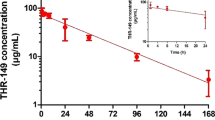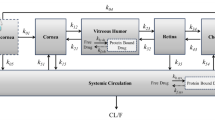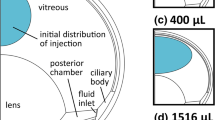Abstract
Purpose
To develop an alternative method for estimating vitreal half-lifes in the rabbit eye based on simple equations for the physical processes of dissipation and the physiochemical properties of therapeutic substances applied by intravitreal drug administration.
Methods
Equations were derived to describe diffusion in the vitreous humor and permeation through the back-of-the-eye tissue, and the volume of distribution. The model was validated using reported half-life values from 83 compounds collected from literature.
Results
The rate limiting step for dissipation from the vitreous depends mainly on the molecular weight. Dissipation of very low molecular weight (MW) substances (<350 Da) is limited by diffusional transport to the back of the eye, for substances with a MW >350 Da uptake into the back of the eye tissue becomes limiting, and large molecules >500 Da predominantly take an alternative path being cleared through the front of the eye for which diffusion towards the posterior chamber turns out to be limiting. Taking the three rate determining processes into account, the derived model can estimate dissipation rates and respectively vitreal half-life values of small compounds and macromolecules from their molecular weight with very few exceptions.
Conclusions
The equations derived in this analysis provide a simple method to predict vitreal half-lifes for a diverse group of molecules and can be easily implemented in early drug development.


Similar content being viewed by others
Abbreviations
- A:
-
Cross section area
- BoE:
-
Back of eye
- CFD:
-
Computational fluid dynamics
- D:
-
Diffusion coefficient
- d:
-
Distance of diffusion path
- Da:
-
Dalton
- eta:
-
Viscosity of the liquid
- f:
-
Fraction
- fu:
-
Fraction unbound
- IVT:
-
Intravitreal
- kB :
-
Boltzmann constant
- kdiss :
-
Dissipation rate
- Km:w:
-
Membrane/water partition coefficient
- Ko:w:
-
Octanol/water partition coefficient
- Kp:w:
-
Protein/water partition coefficient
- Kv:w:
-
Vitreous/water partition coefficient
- MW:
-
Molecular weight
- P:
-
Permeability
- PC:
-
Physicochemical
- QSPKR:
-
Quantitative Structure-Pharmacokinetic Relationships
- r:
-
Radius
- R0 :
-
Hydrodynamic radius of the diffusing particle
- T:
-
Temperature
- t1/2 :
-
Half-life
- Vd :
-
Volume of distribution
- Vvit :
-
Volume of the vitreous
References
Zhang K, Zhang L, Weinreb RN. Ophthalmic drug discovery: novel targets and mechanisms for retinal diseases and glaucoma. Nat Rev Drug Discov. 2012;11:541–59.
del Amo EM, Urtti A. Current and future ophthalmic drug delivery systems. A shift to the posterior segment. Drug Discov Today. 2008;13:135–43.
Washington N, Washington C, Wilson C. Physiological pharmaceutics: barriers to drug absorption. 2nd ed. London: Taylor and Francis; 2001.
Del Amo EM, Vellonen KS, Kidron H, Urtti A. Intravitreal clearance and volume of distribution of compounds in rabbits: In silico prediction and pharmacokinetic simulations for drug development. Eur J Pharm Biopharm. 2015;95:215–26.
Durairaj C, Shah JC, Senapati S, Kompella UB. Prediction of vitreal half-life based on drug physicochemical properties: Quantitative Structure–Pharmacokinetic Relationships (QSPKR). Pharm Res. 2009;26:1236–60.
Haghjau N, Abdekhodaie MJ, Cheng YL. Retina-choroid-sclera permeability for ophthalmic drug in the vitreous to blood direction: quantitative assessment. Pharm Res. 2013;30:41–59.
Haghjou N, Abdekhodaie MJ, Cheng YL, Saadatmand M. Computer modeling of drug distribution after intravitreal administration. World Acad Sci Eng Technol. 2011;5:601–11.
Missel PJ. Hydraulic flow and vascular clearance influences on intravitreal drug delivery. Pharm Res. 2002;19:1636–47.
Stay MS, Xu J, Randolph TW, Barocas VH. Computer simulation of convective and diffusive transport of controlled-release drugs in the vitreous humor. Pharm Res. 2003;20:96–102.
Missel PJ. Simulating intravritreal injections in anatomically accurate models for rabbit, Monkey, and human eyes. Pharm Res. 2012;29:3251–72.
Ahn J, Hyuncheol KH, Woo SJ, Park JH, Park S, Hwang DJ, et al. Pharmacokinetics of intravitreally injected bevacizumab in vitrectomized eyes. J Ocul Pharmacol Ther. 2013;29:612–8.
Maurice DM, Mishima S. Ocular pharmacokinetics. In: Sears L, editor. Pharmacology of the eye. Berlin: Springer; 1984.
Moseley H, Foulds HW, Allan D, Kyle PM. Routes of clearance of radioactive water from the rabbit vitreous. Br J Ophthalmol. 1984;68:145–51.
Laurent UBG, Fraser JRE. Turnover of hyaluronate in the aqueaous humor and vitreous body of the rabbit. Exp Eye Res. 1983;36:493–504.
Wishart DS, Knox C, Guo AC, Shrivastava S, Hassanali M, Stothard P, et al. DrugBank: a comprehensive resource for in silico drug discovery and exploration. Nucleic Acids Res. 2006;34(Database issue):D668–72. 16381955.
Lieb WR, Stein WD. The molecular basis of simple diffusion within biological membranes. In: Bronner F, Kleinzeller A, editors. Current topics in membranes and transport, vol. 2. New York: Academic; 1971.
Polson A. Some aspects of diffusion in solution and a definition of a colloidal particle. J Phys Chem. 1950;54:649–52.
Abdelkawi SA, Abdel-Salam AM, Ghoniem DF, Ghaly SK. Vitreous humour rheology after Nd:YAG laser photo disruption. Cell Biochem Biophys. 2014;68:267–74.
Reichenbach A, Schnitzer J, Friedrich A, Ziegert W, Brückner G, Schober W. Development of rabbit retina, I. Size of eye and retina, and postnatal cell proliferation. Anat Embryol. 1991;183:287–97.
Collander R, Bärlund H. Permeabilitätsstudien an Chara Ceratophyllia. Acta Bot Fenn. 1933;11:1–114.
Levin VA, Dolginow D, Landahl L, Yorke C, Csetjey J. Relationship of octanol/water partition coefficient and molecular weight to cellular permeability and partitioning in S49 lymphoma cells. Pharm Res. 1984;1:259–66.
Lieb WR, Stein WD. Biological membranes behave as non-porous polymeric sheets with respect to the diffusion of non-electrolytes. Nature. 1969;224:240–3.
Schmitt W. General approach for the calculation of tissue to plasma partition coefficients. Toxicol in Vitro. 2008;22:457–67.
Kleinberg TT, Tzekov RT, Stein L, Ravi N, Kaushal S. Vitreous substitutes: a comprehensive review. Surv Ophthalmol. 2011;56:300–23.
Kim JO, Cotlier E. Phospholipid distributions and fatty acid composition of lysophosphatidylcholine and phosphatidylcholine in rabbit aqueous humor, lens and vitreous. Exp Eye Res. 1976;22:569–76.
Keldenich J, Schmitt W, Willmann S. A physiological model for predicting organ/plasma partitioning and volume of distribution. In: Testa B, Krämer SD, Wunderli-Allensbach H, Folkers G, editors. Biological and physicochemical profiling in drug research. VHCA, Zurich, and Wiley-VCH, Weinheim; 2004.
Renkin EM. Filtration, diffusion, and molecular sieving through porous cellulose membranes. J Gen Physiol. 1954;38:225–43.
Liu W, Liu QF, Perkins R, Drusano G, Louie A, Madu A, et al. Pharmacokinetics of sparfloxacin in the serum and vitreous humor of rabbits: physicochemical properties that regulate penetration of quinolone antimicrobials. Antimicrob Agents Chemother. 1988;42:1417–23.
Laude A, Tan LE, Wilson CG, Lascaratos G, Elashry M, Aslam T, et al. Intravitreal therapy for neovascular age-related macular degeneration and inter-individual variations in vitreous pharmacokinetics. Prog Retin Eye Res. 2010;29:466–75.
ACKNOWLEDGMENTS AND DISCLOSURES
The author thanks Anne von Bodman for her writing support. Likewise the critical questions and suggestion of the reviewers are acknowledged, which helped to improve the manuscript very much in a revised version.
Author information
Authors and Affiliations
Corresponding author
Electronic supplementary material
Below is the link to the electronic supplementary material.
ESM 1
(DOCX 104 kb)
Rights and permissions
About this article
Cite this article
Schmitt, W. Estimation of Intra-vitreal Half-Lifes in the Rabbit Eye with Semi-mechanistic Equations. Pharm Res 34, 49–57 (2017). https://doi.org/10.1007/s11095-016-2037-7
Received:
Accepted:
Published:
Issue Date:
DOI: https://doi.org/10.1007/s11095-016-2037-7




